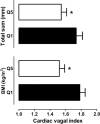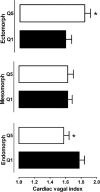Lower cardiac vagal tone in non-obese healthy men with unfavorable anthropometric characteristics
- PMID: 20126345
- PMCID: PMC2815282
- DOI: 10.1590/S1807-59322010000100008
Lower cardiac vagal tone in non-obese healthy men with unfavorable anthropometric characteristics
Abstract
Objectives: to determine if there are differences in cardiac vagal tone values in non-obese healthy, adult men with and without unfavorable anthropometric characteristics.
Introduction: It is well established that obesity reduces cardiac vagal tone. However, it remains unknown if decreases in cardiac vagal tone can be observed early in non-obese healthy, adult men presenting unfavorable anthropometric characteristics.
Methods: Among 1688 individuals assessed between 2004 and 2008, we selected 118 non-obese (BMI <30 kg/m(2)), healthy men (no known disease conditions or regular use of relevant medications), aged between 20 and 77 years old (42 +/- 12-years-old). Their evaluation included clinical examination, anthropometric assessment (body height and weight, sum of six skinfolds, waist circumference and somatotype), a 4-second exercise test to estimate cardiac vagal tone and a maximal cardiopulmonary exercise test to exclude individuals with myocardial ischemia. The same physician performed all procedures.
Results: A lower cardiac vagal tone was found for the individuals in the higher quintiles - unfavorable anthropometric characteristics - of BMI (p=0.005), sum of six skinfolds (p=0.037) and waist circumference (p<0.001). In addition, the more endomorphic individuals also presented a lower cardiac vagal tone (p=0.023), while an ectomorphic build was related to higher cardiac vagal tone values as estimated by the 4-second exercise test (r=0.23; p=0.017).
Conclusions: Non-obese and healthy adult men with unfavorable anthropometric characteristics tend to present lower cardiac vagal tone levels. Early identification of this trend by simple protocols that are non-invasive and risk-free, using select anthropometric characteristics, may be clinically useful in a global strategy to prevent cardiovascular disease.
Keywords: Anthropometric; Autonomic nervous system; Body mass index; Somatotype; Waist circumference.
Figures
Similar articles
-
Cardiac vagal tone, a non-invasive measure of parasympathetic tone, is a clinically relevant tool in Type 1 diabetes mellitus.Diabet Med. 2017 Oct;34(10):1428-1434. doi: 10.1111/dme.13421. Epub 2017 Aug 17. Diabet Med. 2017. PMID: 28703868
-
Normotensive individuals with exaggerated exercise blood pressure response have increased cardiac vagal tone.Arq Bras Cardiol. 2010 Jul;95(1):85-90. doi: 10.1590/s0066-782x2010005000078. Epub 2010 Jun 25. Arq Bras Cardiol. 2010. PMID: 20563512 English, Portuguese.
-
Cardiac parasympathetic activity is increased by weight loss in healthy obese women.Obes Res. 2001 Oct;9(10):637-43. doi: 10.1038/oby.2001.84. Obes Res. 2001. PMID: 11595781 Clinical Trial.
-
Untangling Waist Circumference and Hip Circumference from Body Mass Index with a Body Shape Index, Hip Index, and Anthropometric Risk Indicator.Metab Syndr Relat Disord. 2018 May;16(4):160-165. doi: 10.1089/met.2017.0166. Epub 2018 Mar 13. Metab Syndr Relat Disord. 2018. PMID: 29649376 Review.
-
Toward understanding respiratory sinus arrhythmia: relations to cardiac vagal tone, evolution and biobehavioral functions.Biol Psychol. 2007 Feb;74(2):263-85. doi: 10.1016/j.biopsycho.2005.11.014. Epub 2006 Nov 1. Biol Psychol. 2007. PMID: 17081672 Review.
Cited by
-
Heart rate variability in shift workers: responses to orthostatism and relationships with anthropometry, body composition, and blood pressure.Biomed Res Int. 2015;2015:329057. doi: 10.1155/2015/329057. Epub 2015 Oct 1. Biomed Res Int. 2015. PMID: 26495293 Free PMC article.
-
4-Second Exercise Test: Reference Values for Ages 18-81 Years.Arq Bras Cardiol. 2015 May;104(5):366-74. doi: 10.5935/abc.20150026. Epub 2015 Mar 27. Arq Bras Cardiol. 2015. PMID: 25830712 Free PMC article.
-
Cardiac vagal withdrawal and reactivation during repeated rest-exercise transitions.Eur J Appl Physiol. 2010 Nov;110(5):933-42. doi: 10.1007/s00421-010-1555-y. Epub 2010 Jul 20. Eur J Appl Physiol. 2010. PMID: 20645106 Clinical Trial.
References
-
- World Health Organization - Obesite and overweight 2003(Accessed April, 2009, at http://www.who.int/mediacentre/factsheets/fs311/en/)
-
- Balkau B, Deanfield JE, Despres JP, Bassand JP, Fox KA, Smith SC, Jr, et al. International Day for the Evaluation of Abdominal Obesity (IDEA): a study of waist circumference, cardiovascular disease, and diabetes mellitus in 168,000 primary care patients in 63 countries. Circulation. 2007;116:1942–51. - PMC - PubMed
-
- Gutin B, Johnson MH, Humphries MC, Hatfield-Laube JL, Kapuku GK, Allison JD, et al. Relationship of visceral adiposity to cardiovascular disease risk factors in black and white teens. Obesity (Silver Spring) 2007;15:1029–35. - PubMed
-
- Ricciardi R, Metter EJ, Cavanaugh EW, Ghambaryan A, Talbot LA. Predicting cardiovascular risk using measures of regional and total body fat. Appl Nurs Res. 2009;22:2–9. - PubMed
-
- Pischon T, Boeing H, Hoffmann K, Bergmann M, Schulze MB, Overvad K, et al. General and abdominal adiposity and risk of death in Europe. N Engl J Med. 2008;359:2105–20. - PubMed
Publication types
MeSH terms
LinkOut - more resources
Full Text Sources




